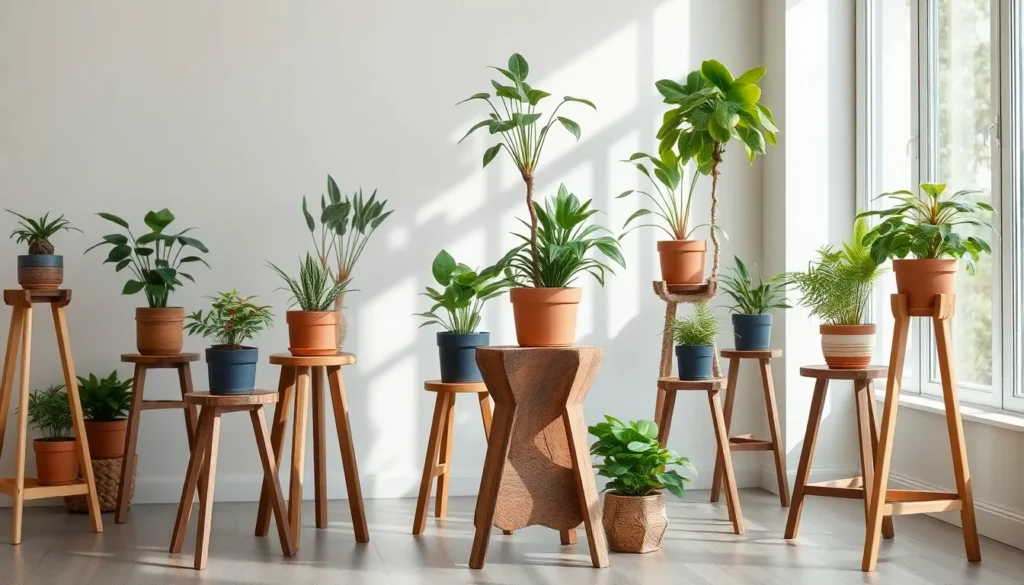We’ve all been there – watching our beloved plants struggle for sunlight while cramped together on windowsills or fighting for space on cluttered surfaces. That’s where wood plant stands transform your indoor garden from chaotic to stunning. These versatile pieces don’t just elevate your plants; they elevate your entire living space.
Wood plant stands offer the perfect blend of functionality and natural beauty that plastic or metal alternatives simply can’t match. They create vertical growing space while adding warmth and organic texture to any room. Whether you’re dealing with a tiny apartment or a spacious home, these stands help you maximize your plant display potential.
We’ll explore everything you need to know about choosing, using, and styling wood plant stands to create the indoor jungle of your dreams. From rustic reclaimed wood to sleek modern designs, there’s a perfect stand waiting to showcase your green companions in their best light.
Choose the Right Wood Type for Your Plant Stand
Selecting the appropriate wood species ensures your plant stand withstands daily use while complementing your home’s aesthetic. Different wood types offer varying levels of durability, cost effectiveness, and visual appeal for your indoor gardening setup.
Hardwood Options for Durability
Oak stands provide exceptional strength and can support multiple heavy plants without warping or sagging over time. This dense wood species features prominent grain patterns that add character to any room while maintaining structural integrity for decades.
Maple offers excellent moisture resistance properties that protect your investment from water damage during routine plant care. We recommend maple for plant enthusiasts who frequently water their collections since this hardwood naturally repels moisture better than softer alternatives.
Cherry wood develops a rich patina over time that enhances the beauty of your plant display area. The natural aging process creates depth and warmth that perfectly complements green foliage and adds sophistication to modern or traditional interiors.
Walnut provides premium quality construction with distinctive dark grain patterns that create stunning focal points in any space. This luxury hardwood option costs more initially but delivers lasting value through superior durability and timeless visual appeal.
Softwood Alternatives for Budget-Friendly Choices
Pine offers an affordable entry point for DIY enthusiasts who want to build custom plant stands without breaking their budget. This lightweight wood accepts stains and paints easily, allowing you to match existing furniture or create unique color schemes.
Cedar naturally resists insects and decay while providing pleasant aromatic qualities that enhance your indoor environment. We find cedar particularly suitable for herb gardens since the wood’s natural oils won’t interfere with edible plants.
Fir delivers reliable strength at reasonable prices and works well for simple geometric designs or minimalist plant stand projects. The straight grain pattern creates clean lines that suit contemporary homes and modern decorating styles.
Spruce provides consistent quality across different price ranges and accepts various finishes that protect the wood while highlighting its natural beauty. This versatile softwood option accommodates both rustic farmhouse looks and sleek urban aesthetics.
Weather-Resistant Wood Species for Outdoor Use
Teak stands excel in outdoor conditions due to natural oils that repel water, insects, and UV damage without additional treatments. This premium tropical hardwood maintains its appearance and structural integrity through seasons of rain, snow, and intense sunlight.
Redwood contains natural preservatives that protect against rot and insect damage while developing an attractive silver gray patina when left untreated. We recommend redwood for gardeners who prefer low maintenance outdoor plant displays that age gracefully.
White oak offers superior weather resistance compared to red oak varieties and provides excellent value for outdoor plant stand construction. The tight grain structure prevents water penetration while the wood’s natural tannins resist decay and insect damage.
Cypress thrives in humid conditions and naturally resists moisture related problems that plague other wood species in outdoor environments. This southern favorite combines durability with distinctive grain patterns that complement both formal and casual garden settings.
Consider Size and Weight Capacity Before Purchasing

Wood plant stands provide sturdy support for heavy pots, especially when made from treated or sealed wood to prevent water damage. Selecting the right stand requires careful evaluation of your space limitations and plant requirements.
Measuring Your Available Space
Measure your designated area carefully to ensure the wood stand fits comfortably without overcrowding. Consider the height, width, and depth in relation to your plant sizes and room layout to prevent cramped conditions.
Room size and sunlight exposure influence the choice of location and stand size. Ensure enough space for plants to grow vertically and horizontally while maintaining easy access for watering and maintenance.
Floor space calculations should include clearance around the stand for foot traffic. Leave at least 18 inches between the stand and nearby furniture or walls to create breathing room in your living space.
Calculating Plant and Pot Weight Requirements
Add the weight of the plant and its pot to determine total load requirements. Choose a wood stand rated to support at least this weight plus a 25% safety margin to prevent structural failure over time.
Weight capacity varies by design and construction materials. For example, a bamboo stand can hold pots up to 44 pounds and may feature adjustable dimensions to fit different pot sizes effectively.
Stability of the stand base directly affects weight bearing capacity. Wider bases and multiple legs increase load distribution and reduce tipping risks, especially when supporting large ceramic or concrete planters.
Hardwood stands made from bamboo or acacia offer superior strength compared to softwood alternatives. Treated softwoods like carbonized pine eliminate moisture content, providing enhanced durability for heavier plant collections.
Multi-Tier Options for Maximum Plant Display
Multi-tier wooden stands maximize vertical space while allowing more plants to be displayed elegantly without consuming excessive floor space. These designs transform unused wall areas into productive growing zones.
Shelves at varying heights prevent overshadowing of smaller plants by taller specimens. This arrangement enhances light access for all plants while creating visually appealing layered displays throughout your home.
Enhanced stability features include multiple legs and support structures to prevent tipping. Multi-tiered designs distribute weight across several contact points, accommodating multiple plants at different elevations safely.
Design examples include 2-tier ladder style stands with slatted shelves for drainage or 9-tier multifunctional units. These versatile stands combine plant display capabilities with storage space for garden tools, fertilizers, or decorative accessories.
Match Your Wood Stand Style to Your Home Decor
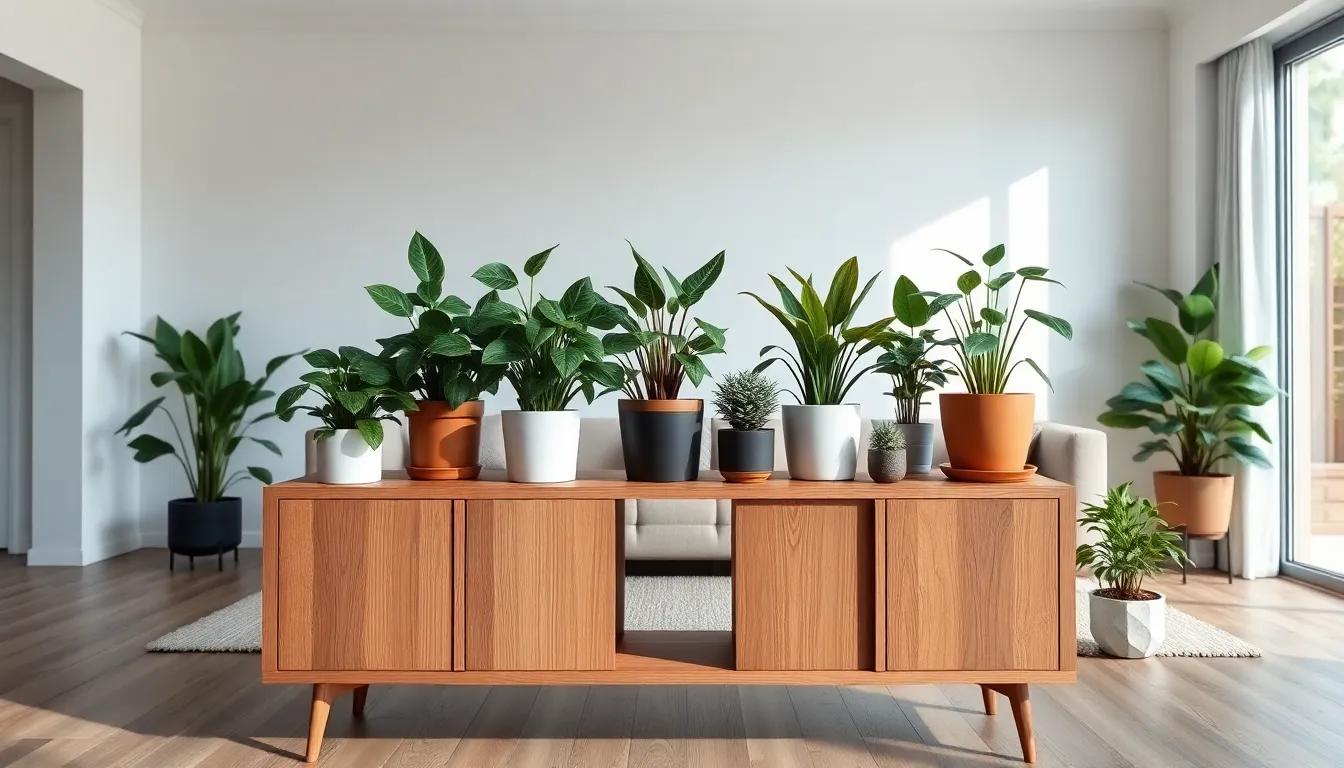
Choosing the perfect wood plant stand involves matching its design aesthetic to your existing home decor style. We’ll explore three popular design approaches that complement different interior themes.
Modern Minimalist Wood Plant Stands
Clean lines and subtle designs define modern minimalist wood plant stands that keep attention focused on your plants rather than the stand itself. These stands feature simple geometric shapes with natural wood finishes and eliminate ornate details completely. Scandinavian and contemporary interiors benefit most from these sleek, understated pieces that elevate plants without overwhelming the space.
Neutral color palettes work beautifully with minimalist stands since their uncluttered appearance maintains visual harmony. Simple platform designs or basic ladder styles exemplify this aesthetic perfectly. We recommend choosing stands with smooth, untreated wood surfaces that showcase the natural grain without distraction.
Rustic and Farmhouse-Style Options
Natural wood grains and distressed finishes characterize rustic and farmhouse-style wood plant stands that bring warmth and character to any room. These stands often feature vintage touches or rough hewn textures that create an organic, earthy atmosphere. Handcrafted details like visible joinery or weathered edges add authentic charm to plant displays.
Reclaimed wood or unfinished timber materials work exceptionally well for achieving this cozy, country inspired look. Barnwood aesthetics and mason jar holders complement these stands perfectly. We suggest selecting pieces with visible wood imperfections that tell a story and enhance the rustic appeal.
Industrial Wood and Metal Combinations
Metal frames paired with wooden shelves create industrial style plant stands that blend urban edge with natural warmth. These sturdy combinations balance roughness with refinement by mixing raw materials like steel and natural wood. Loft apartments and modern industrial interiors showcase these stands most effectively.
Black metal pipes combined with thick wooden platforms exemplify this design approach perfectly. Exposed hardware and utilitarian shapes enhance the industrial aesthetic significantly. We recommend choosing stands with dark metal finishes that contrast beautifully with lighter wood tones for maximum visual impact.
Evaluate Different Wood Stand Designs and Configurations
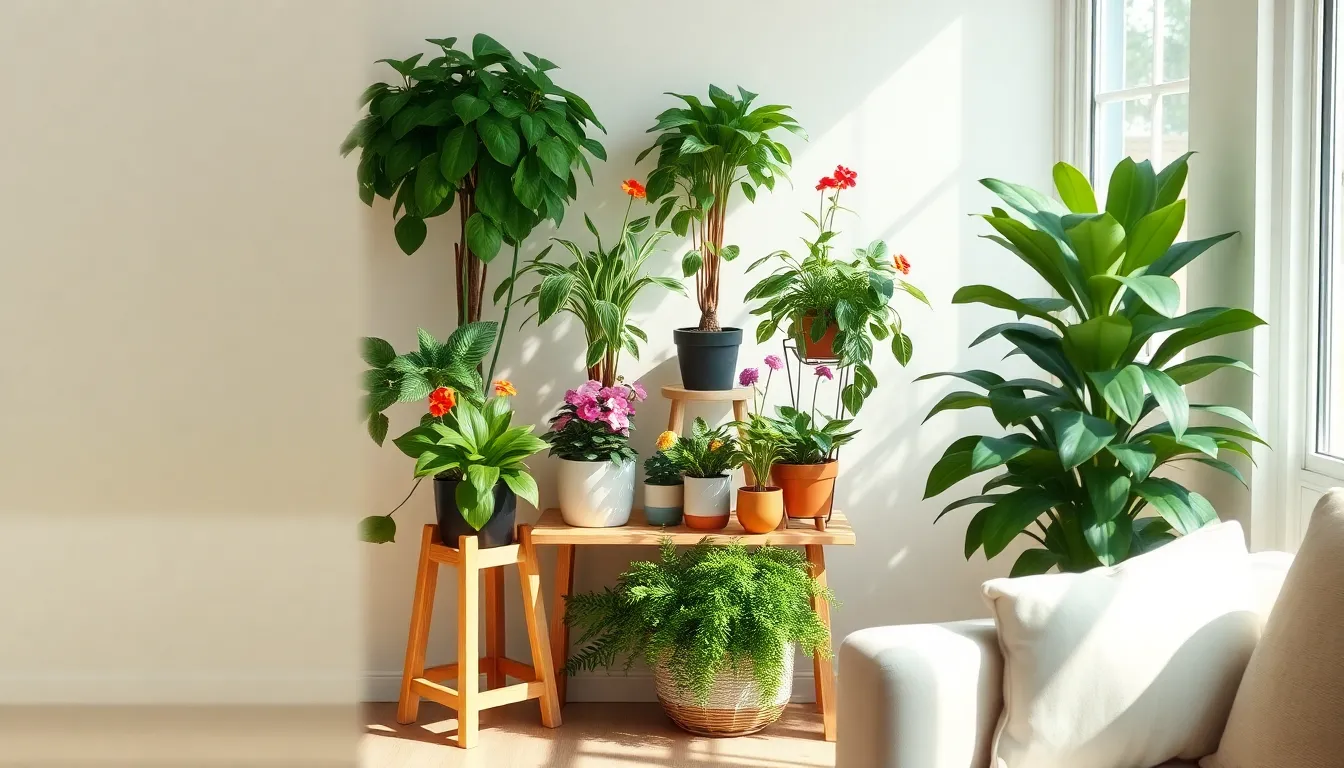
Understanding the various wood plant stand configurations helps us choose the perfect design for our exact needs and space requirements.
Single Plant Pedestals and Accent Stands
Single plant pedestals showcase individual botanical specimens as striking focal points in our homes. These elegant stands feature circular, square, or uniquely artistic forms crafted from solid or engineered wood that provide both sturdy support and visual appeal.
Weight capacity typically reaches 100 pounds or more, making these stands suitable for larger plants and decorative pots. Space conscious homeowners find these pedestals ideal for highlighting prized plants without overwhelming smaller rooms.
Design versatility allows us to select from simple geometric shapes or more elaborate artistic forms. Natural wood grains and various finishes ensure these accent stands complement our existing decor while drawing attention to our favorite plants.
Corner Plant Stands for Space Optimization
Corner plant stands maximize underutilized spaces through their triangular or multi-tiered design configurations. These specially shaped stands fit snugly into corners while accommodating several pots simultaneously in compact arrangements.
Triangular construction increases weight capacity compared to traditional rectangular designs. Balanced sunlight exposure becomes possible when plants are arranged on different tiers, ensuring each specimen receives adequate light throughout the day.
Multi-tiered corner designs work exceptionally well in small rooms or balconies where floor space is limited. Plant groupings create visual impact while maintaining organized displays in areas that might otherwise remain empty.
Rolling Plant Stands for Easy Mobility
Rolling wood plant stands combine aesthetic appeal with practical functionality through their wheel equipped bases. Movement becomes effortless when we need to relocate plants from patios to greenhouses or rearrange displays based on seasonal sunlight patterns.
Multi-tiered construction with slatted surfaces promotes proper drainage and air circulation around plant containers. Ventilation benefits support healthier root systems and prevent water accumulation that could damage our plants.
Cleaning tasks become simpler when we can easily move stands away from walls or furniture. Seasonal transitions allow us to bring outdoor plants inside during colder months without struggling to lift heavy arrangements.
| Design Type | Space Use | Mobility | Capacity & Material | Benefits |
|---|---|---|---|---|
| Single Plant Pedestals | Small/Accent spaces | Fixed | Solid/engineered wood, supports ~100 lbs | Highlights individual plants |
| Corner Plant Stands | Corner optimization | Fixed | Triangular, multi-tiered, solid wood | Maximizes space, good light balance |
| Rolling Plant Stands | Flexible placement | Mobile | Multi-tiered, slatted for drainage, wheels | Easy to move, promotes healthy growth |
Maintain Your Wood Stand for Plants Properly
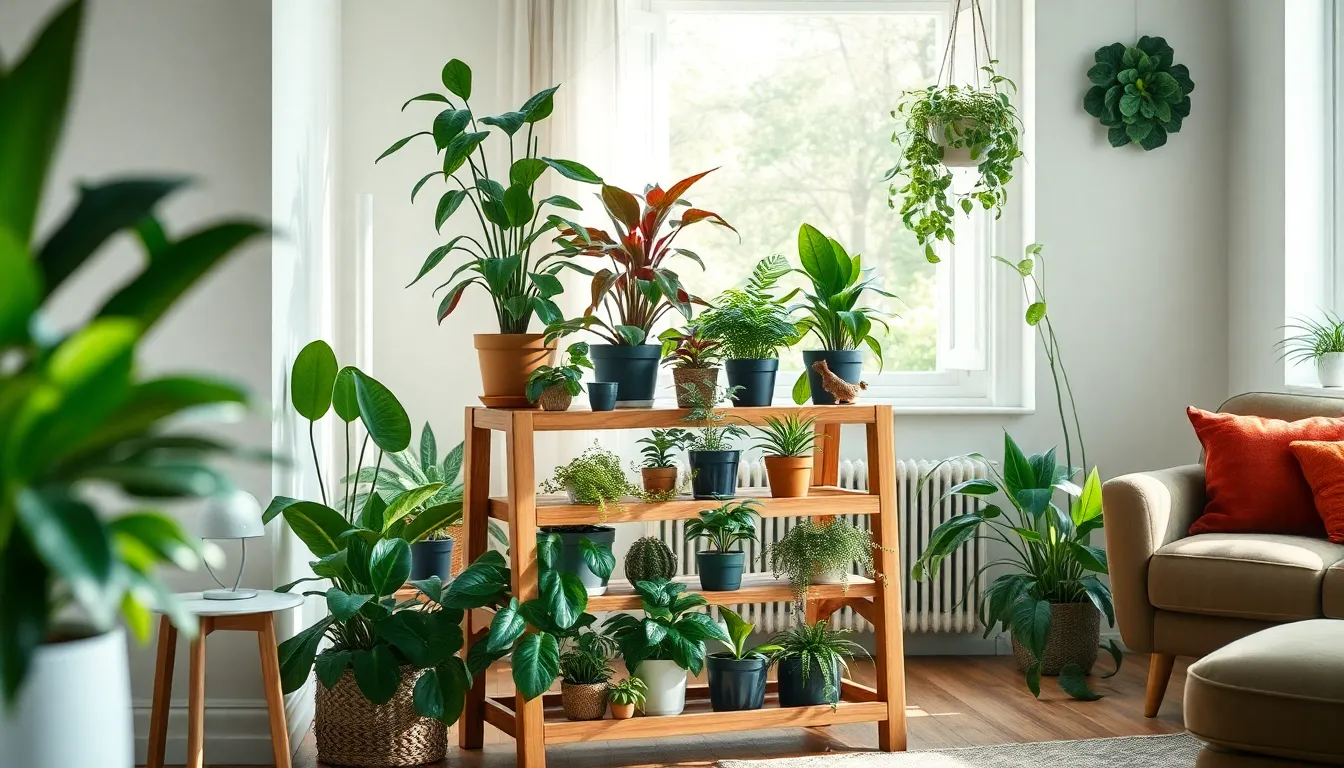
Once you’ve found the perfect wood plant stand for your home, proper maintenance ensures it’ll remain beautiful and functional for years. Regular care protects your investment while keeping your plants healthy and your decor looking its best.
Regular Cleaning and Dusting Techniques
Dust your wood stand weekly using a soft cloth to prevent buildup that can dull the finish and attract moisture. This simple step keeps your stand looking fresh while protecting the wood’s natural beauty.
Clean spills immediately with a slightly damp cloth, then thoroughly dry the area to avoid water stains or permanent damage. Quick action prevents minor accidents from becoming major problems.
Deep clean outdoor stands annually using soap and a degreaser to remove algae or dirt buildup, especially when the wood starts turning gray. Products like Trip Trap degreaser work effectively without harsh chemicals.
Avoid chemical cleaners that can strip your wood’s natural finish and cause long term damage. Natural soap or specialized wood cleaners preserve the wood’s integrity while removing dirt and grime.
Protecting Wood from Water Damage
Apply penetrating oils regularly such as teak oil, linseed oil, or specially formulated wood oils to repel water and maintain natural resistance. Indoor stands need treatment every 2-3 years, while outdoor stands require annual applications.
Position stands strategically away from locations with excessive direct water contact or high humidity without proper protection. Smart placement prevents most water damage before it starts.
Ensure proper drainage around outdoor stands and prevent water from pooling at the base to minimize long term damage. Good drainage extends your stand’s lifespan significantly.
Monitor moisture levels since wood is sensitive to prolonged exposure that can lead to warping, cracking, or rot. Early detection helps you address problems before they become serious.
Seasonal Care and Refinishing Tips
Inspect stands seasonally for signs of wear, cracks, or lost finish at the change of each season. Regular inspections help you catch problems early when they’re easier to fix.
Sand lightly before refinishing to prepare the surface for fresh coats of oil or wood finish that restore color and protect against future damage. Light sanding creates better adhesion for protective treatments.
Apply oil or colored preservatives to outdoor stands to restore faded wood and protect against UV damage from sun exposure. This treatment keeps your stands looking vibrant year round.
Check hardware regularly by tightening loose screws or joints to maintain stability and safety for your plants. Secure connections prevent accidents and extend your stand’s useful life.
Compare DIY Versus Store-Bought Options
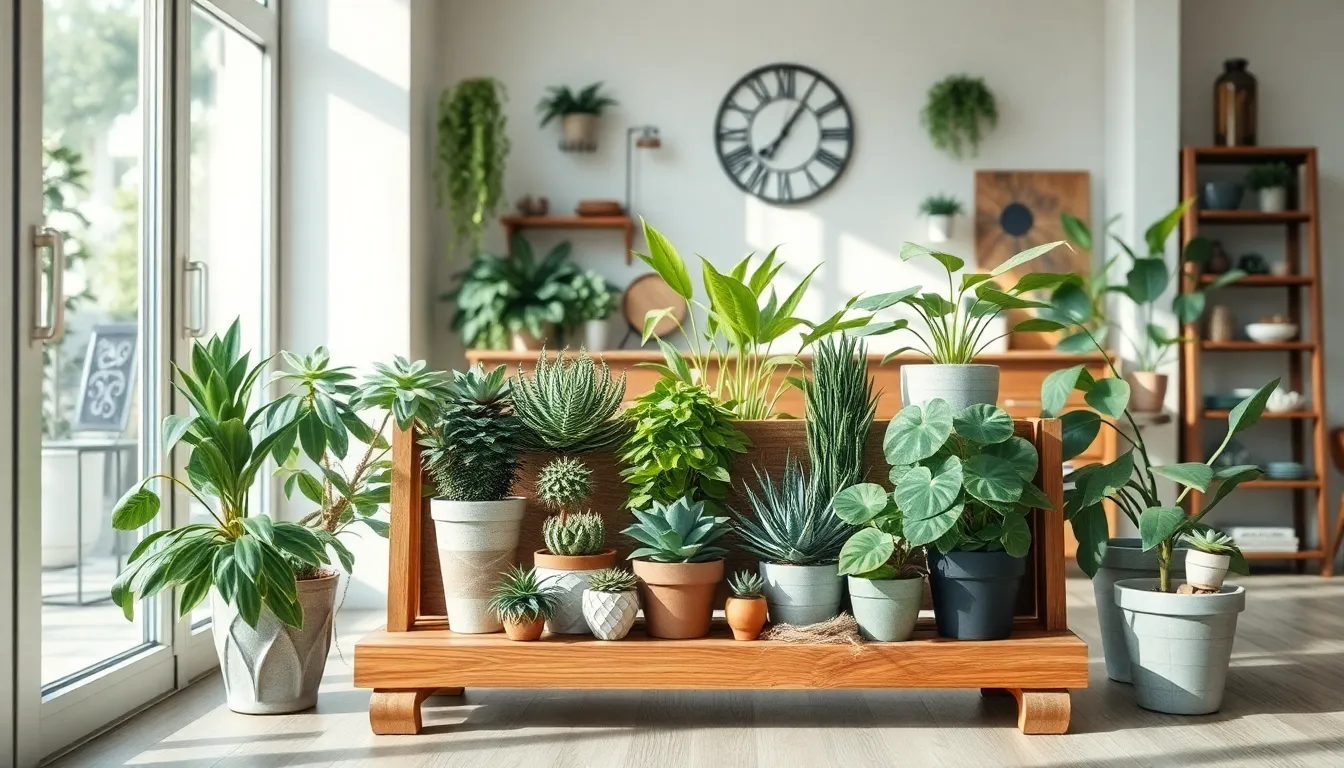
We’re diving into the key differences between crafting your own wooden plant stand and purchasing a ready-made option. Both approaches offer distinct advantages depending on your priorities, skills, and timeline.
Building Your Own Custom Wood Plant Stand
Complete customization leads the list of benefits when you build your own wood plant stand. We can design adjustable shelves and varying heights that perfectly accommodate small succulents, trailing vines, or large leafy plants while creating a visually curated display.
Material selection becomes entirely yours with DIY projects. We’ll choose the exact wood type, finishes, and style to match our décor preferences, whether we’re aiming for rustic charm or modern minimalism. Custom features like drainage slats or multi-tier shelving enhance plant health while serving our exact needs.
Woodworking skills and tools are required for successful DIY projects. We must invest time learning techniques if we’re beginners or dust off existing skills if we’ve built furniture before. Proper equipment like saws, sanders, and finishing materials becomes necessary for quality results.
Time and Cost Considerations for DIY Projects
Extended timelines characterize most DIY wood stand projects compared to immediate store purchases. We’ll spend hours designing, measuring, cutting, assembling, sanding, and applying finishes before our stand is ready for plants.
Variable costs depend heavily on our material choices and existing tool inventory. We might spend less than store-bought options if we already own woodworking tools, or significantly more if we need to purchase everything from scratch.
Additional expenses include sealants and wood treatments that protect against moisture and extend durability. We should budget for quality finishes that prevent water damage and maintain the wood’s appearance over time.
Personal satisfaction rewards our time investment when we complete a custom project. We’ll own a unique piece that perfectly fits our space and reflects our craftsmanship skills.
Ready-Made Options for Immediate Use
Instant availability tops the convenience factor for store-bought wood plant stands. We can purchase and start using our new stand the same day without any assembly or finishing work required.
Professional construction ensures reliable quality in manufactured stands. We’ll receive sturdy designs suitable for heavy pots with guaranteed weight capacities and tested stability features.
Diverse style options fill retail catalogs with choices ranging from simple single-tier pedestals to elaborate 9-tier vertical stands that maximize limited floor space. We can browse eco-friendly materials and multifunctional designs that serve multiple purposes.
Limited customization restricts our design freedom with pre-made stands. We must choose from available sizes, colors, and configurations rather than creating exactly what we envision for our space.
| Comparison Factor | DIY Custom Stand | Store-Bought Stand |
|---|---|---|
| Customization Level | Fully customizable to plant sizes and styles | Limited to available designs and sizes |
| Time Investment | High – designing and building involved | Low – immediate use |
| Cost Range | Variable – depends on materials and tools | Fixed price, often competitive |
| Skill Requirements | Woodworking skills needed | None required |
| Durability Assurance | Depends on craftsmanship and materials | Professionally finished and treated |
| Design Variety | Unlimited based on creativity | Wide but fixed catalog options |
| Special Features | Can add drainage and adjustable shelves | Multi-tier and eco-friendly materials available |
Position Your Wood Plant Stand for Optimal Plant Health
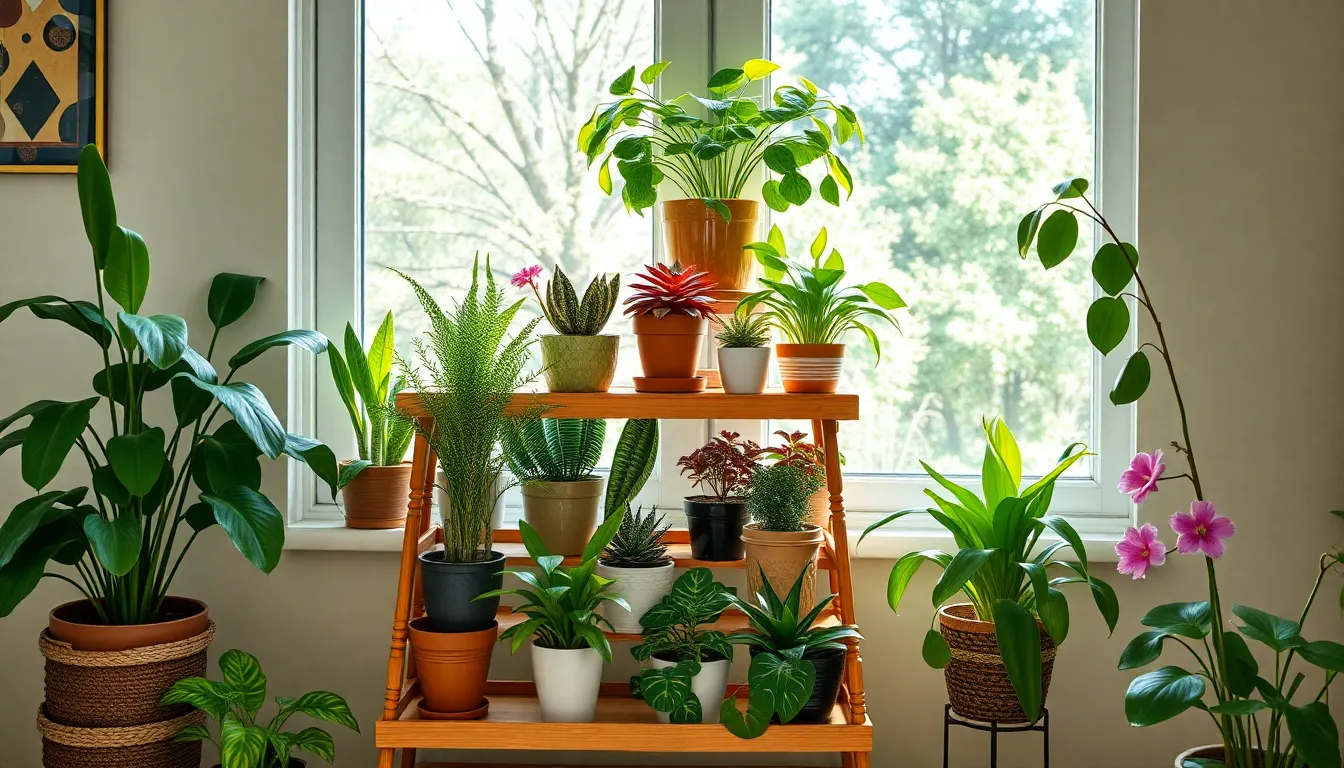
After selecting and setting up your wood plant stand, strategic placement becomes crucial for ensuring your plants flourish in their elevated environment.
Light Requirements and Window Placement
South-facing windows deliver the most intense sunlight throughout the day, making them perfect locations for sun-loving plants like succulents and flowering varieties on your wood stand. We recommend using sheer curtains when the light becomes too harsh to prevent leaf burn on delicate foliage.
East-facing windows provide gentle morning sunlight followed by partial afternoon shade, creating ideal conditions for plants such as ferns and African violets. Position your wood stand approximately 2-3 feet from these windows to capture optimal light levels.
West-facing windows offer stronger afternoon sunlight that benefits plants requiring moderate light exposure, including dracaena and rubber plants. These locations work exceptionally well for multi-tier wood stands where you can arrange plants based on their exact light needs.
Grouping plants with similar light requirements on the same wood stand simplifies care routines while ensuring consistent growing conditions for all specimens. Rotate your plants weekly to promote even light distribution and prevent uneven growth patterns.
Seasonal adjustments become necessary as sunlight intensity and duration change throughout the year. Move your wood stand closer to windows during winter months or supplement with artificial grow lights when natural light becomes insufficient.
Air Circulation and Spacing Considerations
Elevating plants on wood stands dramatically improves air circulation around both foliage and root systems, which proves essential for preventing common plant health issues. Enhanced airflow helps eliminate fungal diseases like mold and mildew while reducing pest infestations that thrive in stagnant, moisture-heavy environments near ground level.
Adequate spacing between plants on your wood stand allows air to circulate freely rather than creating crowded conditions that trap humidity. We suggest maintaining at least 6-8 inches between plant containers to ensure proper ventilation.
Multi-tiered wood stands excel at creating vertical separation that naturally enhances air movement between different plant levels. This design prevents the stagnant air pockets that commonly develop when plants sit too close together on single-level surfaces.
Position your wood stand away from corners or enclosed spaces where air circulation naturally decreases. Central room locations or areas near (but not directly in) air vents provide the best airflow conditions for plant health.
Temperature and Humidity Factors
Wood plant stands should occupy locations where temperature and humidity levels remain stable and appropriate for your exact plant varieties. Avoid placing stands near drafty windows, heating vents, or air conditioning units that create sudden temperature fluctuations.
Most houseplants thrive in moderate indoor temperatures between 65-75°F with humidity levels around 40-60%. Wood stands naturally provide temperature stability since wood doesn’t conduct heat like metal alternatives, helping maintain consistent microenvironments around plant roots.
Strategic placement away from heat sources prevents the rapid soil drying and leaf stress that occurs when plants experience extreme temperature changes. We recommend monitoring the area around your wood stand with a thermometer during different seasons to ensure conditions remain optimal.
Use humidity trays filled with water and pebbles beneath plants on your wood stand to increase local humidity levels, especially during winter months when indoor air becomes particularly dry. Misting plants lightly can also help, though ensure proper air circulation prevents moisture from lingering on leaves.
Consider the thermal properties of different wood types when positioning your stand, as denser hardwoods like oak and maple provide better temperature insulation than lighter softwoods.
Accessorize Your Wood Stand for Enhanced Functionality
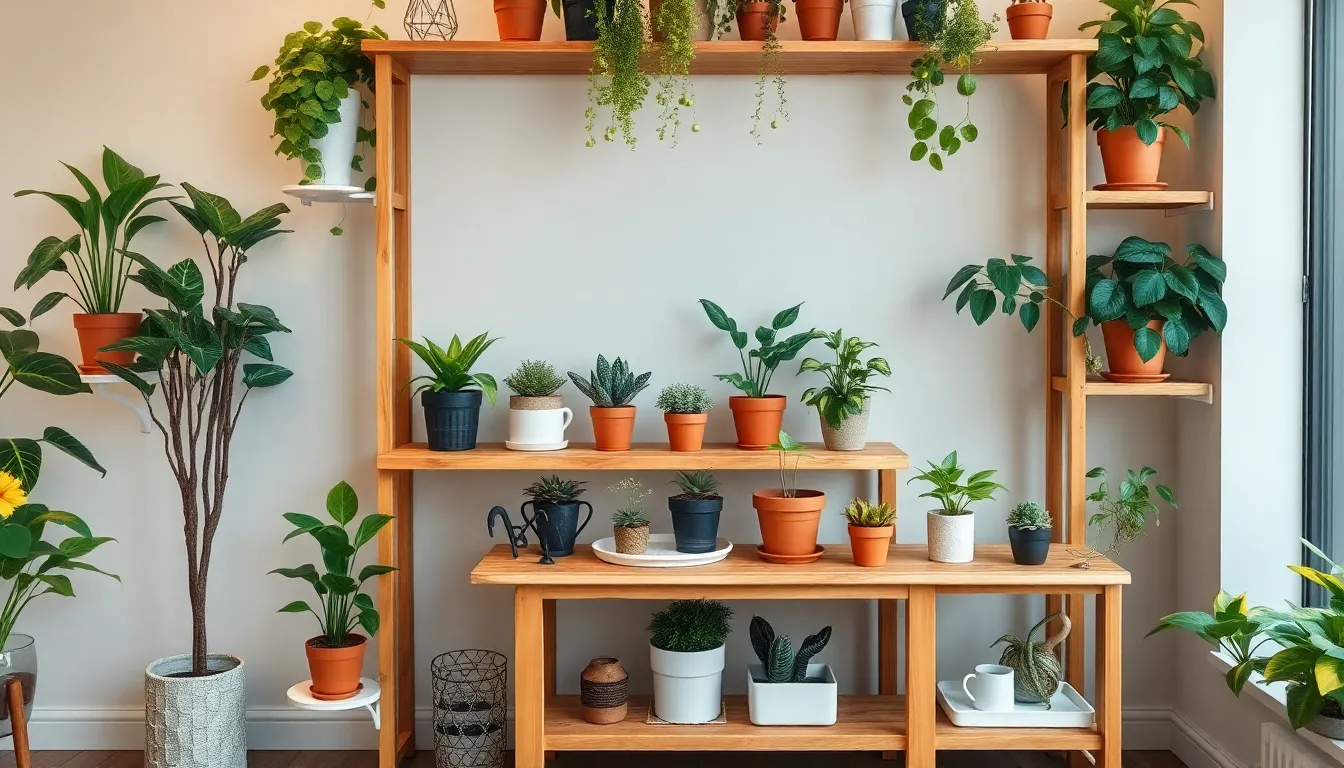
We’ll transform your basic wood plant stand into a multifunctional gardening hub with smart accessories. Strategic additions enhance both plant health and stand longevity while maintaining the aesthetic appeal of your indoor garden.
Adding Protective Saucers and Trays
Protective saucers serve as essential barriers between your plants and wooden surfaces. Water damage prevention becomes crucial since excess moisture can cause stains, warping, and wood rot over time. These practical accessories catch overflow from drainage holes while keeping your stand’s surface clean and dry.
Specialized designs like leaf-shaped “Sausr” trays elevate pots above standing water to prevent root rot. This elevation creates proper drainage while the trapped water increases local humidity levels around your plants. The additional moisture in the air promotes healthier growth patterns and creates a more favorable microclimate for your indoor garden.
Benefits extend beyond protection as decorative saucers complement your wood stand’s natural beauty. Matching materials and finishes create cohesive displays that enhance rather than detract from your plant arrangements. Your investment in quality saucers pays dividends in both plant health and furniture preservation.
Incorporating Decorative Elements
Decorative touches personalize your wood plant stand while maintaining its functional purpose. Monstera leaf-shaped trays introduce whimsical, organic style that naturally complements plant displays. These artistic elements bridge the gap between utility and visual appeal.
Natural wood grain synergizes beautifully with painted or carved designs on the stand itself. We recommend subtle accent lighting to highlight both your plants and the stand’s craftsmanship. Strategic placement of battery-operated LED strips creates dramatic shadows and emphasizes the wood’s texture.
Seasonal decorations allow you to refresh your display throughout the year. Small ornaments, colored stones, or themed accessories can transform your plant stand’s appearance without compromising its structural integrity or plant care functionality.
Storage Answers for Plant Care Supplies
Built-in storage transforms your wood plant stand into a complete plant care station. Hooks attached to the stand’s sides hold watering cans, spray bottles, and small hand tools within easy reach. This organization eliminates trips to storage areas during routine plant maintenance.
Small shelves integrated beneath or alongside the main plant platform accommodate fertilizers, plant food, and pruning supplies. Custom compartments keep essentials organized while maintaining clean lines and visual appeal. Your plant care routine becomes more efficient with everything centrally located.
Drawer additions offer concealed storage for less attractive but necessary items like plant ties, stakes, and soil amendments. These hidden compartments maintain the stand’s aesthetic while providing practical organization answers. Proper storage keeps your living space uncluttered and your plant care supplies easily accessible.
Conclusion
Wood plant stands offer the perfect balance of functionality and style for any indoor gardening enthusiast. They transform our living spaces while providing our plants with the elevation and exposure they need to thrive.
Whether we choose a sleek modern design or a rustic farmhouse style our wood stands become more than just plant holders – they’re decorative elements that enhance our home’s aesthetic. The durability and natural beauty of wood make these stands a worthwhile investment that’ll serve us for years to come.
By selecting the right size considering proper maintenance and adding thoughtful accessories we can create stunning plant displays that showcase both our green friends and our personal style. Wood plant stands truly elevate our indoor gardening game.
Frequently Asked Questions
What are the main benefits of using wood plant stands for indoor gardening?
Wood plant stands create vertical growing space for plants struggling with limited floor area and sunlight access. They add natural warmth and texture to any room while providing functional solutions for organizing your indoor garden. Unlike plastic or metal alternatives, wood stands offer superior aesthetic appeal and can transform your living space into a beautiful, organized botanical display.
Which wood types are best for plant stands?
Hardwoods like oak, maple, cherry, and walnut are ideal for their strength and moisture resistance. For budget-friendly options, consider softwoods like pine and cedar. For outdoor use, choose weather-resistant species that offer durability and low maintenance. The key is selecting wood that matches your home decor while providing adequate strength for your plants.
How do I determine the right size and weight capacity for my plant stand?
Measure your available space and consider room size and sunlight exposure to ensure proper fit. Calculate the total weight of all plants and pots you plan to display, then select a stand with weight capacity exceeding this total. Always include a safety margin for structural integrity and account for plant growth over time.
What design styles work best with different home decor?
Modern minimalist stands feature clean lines perfect for Scandinavian and contemporary interiors. Rustic and farmhouse styles bring warmth with natural wood grains and distressed finishes. Industrial wood and metal combinations offer urban edge with natural warmth, ideal for loft apartments and modern industrial spaces. Choose styles that complement your existing decor.
Should I build a DIY plant stand or buy a ready-made one?
DIY stands offer complete customization in design, materials, and features but require woodworking skills, time, and potentially higher costs. Ready-made options provide immediate availability and professional quality with limited customization. Consider your skill level, time availability, budget, and desired customization level when making this decision.
How do I properly maintain my wood plant stand?
Regular cleaning and dusting are essential, along with immediate spill management to prevent water damage. Apply penetrating oils annually to protect the wood and conduct seasonal inspections for wear. For outdoor stands, perform deep cleaning annually and refinish as needed. Regularly check hardware stability to ensure safety and extend the stand’s lifespan.
What accessories can enhance my wood plant stand’s functionality?
Protective saucers and trays prevent water damage while promoting healthy plant growth. Decorative elements like small sculptures or stones can personalize your stand without compromising utility. Built-in storage solutions keep plant care supplies organized and accessible, transforming your stand into a multifunctional gardening hub that serves both aesthetic and practical purposes.
How should I position my wood plant stand for optimal plant health?
Consider your plants’ specific light requirements when positioning stands near windows or artificial light sources. Ensure adequate air circulation around the stand to prevent fungal issues and promote healthy growth. Monitor humidity levels, as wood stands can affect local moisture conditions. Avoid placing stands near heat sources or in drafty areas.

